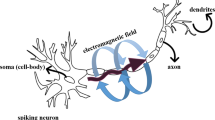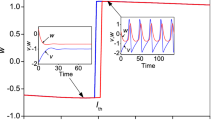Abstract
To investigate the role of electrical junctions in the nervous system, a model system consisting of two nearly identical neurons electrotonically coupled is studied. We assume that each neuron discharges a train of impulses or bursts either spontaneously or under constant stimulus via chemical synapses. It is known that not only an electric current but also chemical substances whose molecular weight is about 1000 can pass through the junction of an electrical synapse (gap junction). So, our model system is regarded as a set of non-linear oscillators coupled by diffusion, and it may be described by a system of ordinary differential equations. Neurons are excited constantly when they are stimulated by an electric current above the threshold level. Therefore, we expect Hopf bifurcation to occur at the critical magnitude of a stimulating electric current in the system of differential equations which describes the dynamics of a single neuron. Studying our model system according to the theory of Hopf bifurcation, we found regions of diffusion constants of the electrical junction which give two kinds of periodic solutions. One is the solution where two neurons oscillate in phase synchrony. The other is where two neurons oscillate 180° out of phase. In the case where one neuron is described by the BVP model, the following was found by computer simulation. When the initial difference between the phase of two neurons is small, the two neurons come to oscillate synchronously. If the initial difference is large, however, the two come to be excited alternately. The physiological implications of these results are discussed.
Similar content being viewed by others
References
Ashkenaji, M., Othmer, H.G.: Spatial patterns in coupled biochemical oscillators. J. Math. Biology 5, 305–350 (1978)
Bennett, M.V.L.: Electrical transmission: a functional analysis and comparison to chemical transmission. In: Handbook of physiology, Vol. 1, pp. 357–416. Kandel, E.R., (ed.). Bethesda, Maryland: American Physiological Society 1977
Eccles, R.M., Liebet, B.: Origin and blockade of the synaptic responses of curarized sympathetic ganglia. J. Physiol. 157, 484–503 (1961)
Fitzhugh, R.: Impulses and physiological states in theoretical models in nerve membrane. Biophys. J. 1, 445–466 (1961)
Greengard, P., Kebabian, J.W.: Role of cyclic AMP in synaptic transmission in the mammalian peripheral nervous system. Fed. Proc. 33, 1059–1067 (1974)
Hadeler, K.P., an der Heiden, U., Schumacher, K.: Generation of the nervous impulse and periodic oscillations. Biol. Cybernetics 23, 211–218 (1976)
Harmon, L.D.: Neuromimes; action of a reciprocally inhibiting pair. Science 146, 1323–1325 (1964)
Hassard, B.: Bifurcation of periodic solutions of the Hodgkin-Huxley model for the squid giant axon. J. Theor. Biol. 71, 401–420 (1978)
Hirsch, M.W., Smale, S.: Differential equations, dynamical systems, and linear algebra. New York: Academic Press 1974
Hodgkin, A.L., Huxley, A.F.: A quantitative description to conduction and excitation in nerve. J. Physiol. 117, 500–544 (1952)
Kanno, Y., Loewenstein, W.R.: Cell-to-cell passage of large molecules. Nature 212, 629–630 (1966)
Kawato, M., Suzuki, R.: Biological oscillators can be stopped-topological study of a phase response curve. Biol. Cybernetics 30, 241–248 (1978)
Kennedy, D., Davis, W.J.: Organization of invertebrate motor systems. In: Handbook of physiology, Vol. 1, pp. 1023–1087. Kandel, E.R., ed. Bethesda, Maryland: American Physiological Society 1977
Llinas, R., Baker, R., Sotelo, C.: Electronic coupling between neurons in cat inferior olive. J. Neurophysiol. 37, 560–571 (1974)
Marsden, J.E., McCracken, M.: The Hopf bifurcation and its applications. Berlin, Heidelberg, New York: Springer 1976
Prigogine, I., Lefever, R.: Symmetry breaking instabilities in dissipative systems. II. J. Chem. Phys. 48, 1695–1700 (1968)
Selverston, A.: A model system for the study of rhythmic behavior. In: Simpler networks and behavior, pp. 82–98. Fentress, J.C. (ed.). Sunderland, Mass.: Sinauer 1976
Suzuki, R., Katsuno, I., Matano, K.: Dynamics of neuronring. Kybernetik 8, 39–45 (1971)
Torre, V.: Synchronization of non-linear biochemical oscillators coupled by diffusion. Biol. Cybernetics 17, 137–144 (1975)
Torre, V.: A theory of synchronization of heart pace-maker cells. J. Theor. Biol. 61, 55–71 (1976)
Tyson, J., Kauffman, S.: Control of mitosis by a continuous biochemical oscillation: synchronization; spatially inhomogeneous oscillations. J. Math. Biol. 1, 289–310 (1975)
Author information
Authors and Affiliations
Additional information
Department of Behaviorology, Faculty of Human Sciences
Rights and permissions
About this article
Cite this article
Kawato, M., Sokabe, M. & Suzuki, R. Synergism and antagonism of neurons caused by an electrical synapse. Biol. Cybernetics 34, 81–89 (1979). https://doi.org/10.1007/BF00365472
Received:
Issue Date:
DOI: https://doi.org/10.1007/BF00365472




